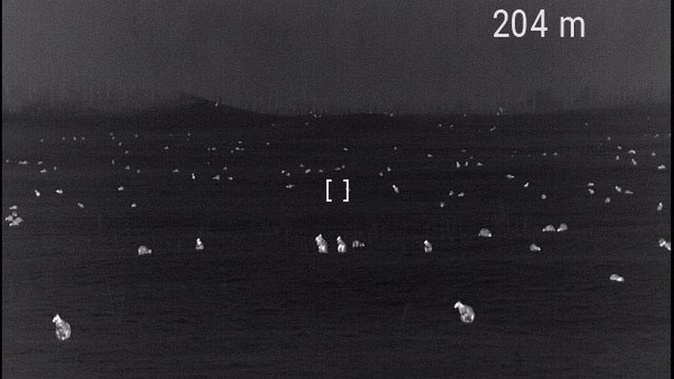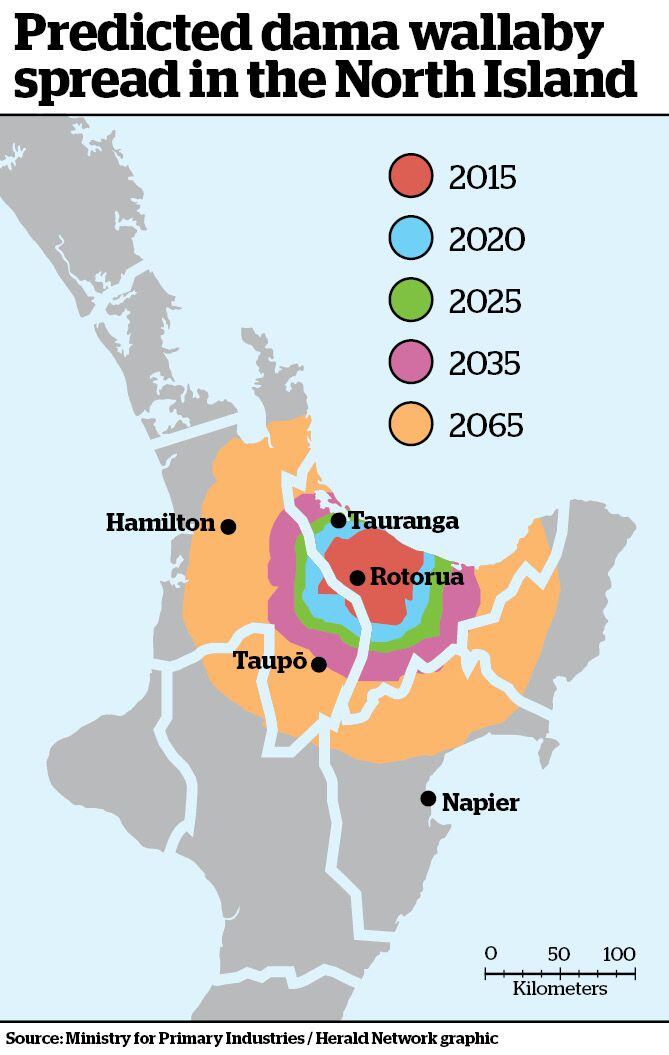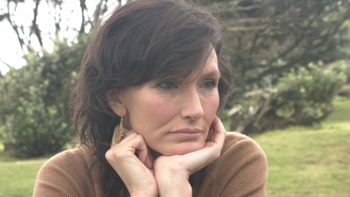

Kilometres of fence line have been laid in Rotorua as part of an attempt to halt potentially millions of dollars in wallaby damage.
Dama wallabies have called Rotorua home for more than 100 years but, unless they are controlled, they could cause an estimated $16.5 million in damage by 2025 in the North Island, according to Biosecurity New Zealand.
The agency leads the Tipu Mātoro National Wallaby Eradication Programme, working with councils, iwi, landowners and other groups.
Wallabies feed on native flora important to native wildlife as well as compete with stock on farmland for pasture. They also damage pine and eucalyptus seedlings on plantations.
Of the 962 wallaby sightings reported in the Bay of Plenty in the past two-and-a-half years, 764 were in the Rotorua area.
There are an estimated 1 million wallabies in the country, but how many are in the region is not known.
A project began at the end of last year to build a 12.5km wallaby-proof fence designed to keep the pests in a limited area to stop their spread.
/cloudfront-ap-southeast-2.images.arcpublishing.com/nzme/GGO4I6SKM5DC7MVNPRJJV7EPHY.jpg) There are an estimated 1 million wallabies in New Zealand, including dama wallabies in the North Island.
There are an estimated 1 million wallabies in New Zealand, including dama wallabies in the North Island.
Construction of 7.3km of fence has been finished and the full 12.5km is expected to be completed by mid-September.
Bay of Plenty Regional Council’s North Island wallaby programme manager Davor Bejakovich said the fence supported the aim to have all wallabies within designated containment areas by 2025.
The full containment area in the North Island is about 260,000 hectares, mostly in the Rotorua district.
The fence under construction runs from Waipa to Lake Rotokakahi and was designed to help keep wallabies inside the containment area at the Whakarewarewa Forest, as well as to stop re-infestation of land to the south where wallaby control measures had been carried out.
The area south of the fence will be surveyed to measure its success.
/cloudfront-ap-southeast-2.images.arcpublishing.com/nzme/O6NXZCADJBGU3MJZ4QB2SYQ6OQ.JPG)
“While the long-term aspiration of the programme is to achieve a wallaby-free Aotearoa, it will take the continued efforts of programme partners, landowners and the wider community to achieve this goal,” Bejakovich said.
The short-term focus was to find and control wallabies outside of the containment area.
Then the focus would shift to those inside it and reducing populations in size and range.
A Central North Island regional co-ordination group, which consists of representatives from iwi, community care groups, Forest and Bird, forestry and Federated Farmers, meets quarterly to provide feedback on the programme’s operations and progress.
Bejakovich said landowners, including many farmers, had supported the programme’s goals.

Reporoa dairy farmer and Federated Farmers Rotorua/Taupō provincial president Colin Guyton said he had never seen any of the Aussie invaders as far south as his farm but he worried about if that day should come.
“They really are a problem. We should have gotten on top of them a lot earlier maybe, but at least we are doing something now.”
They were similar to rabbits in how devastating they could be with how much they ate, he said, and their nocturnal tendencies made them a challenge to tackle.
On social media last year the Bay of Plenty Regional Council shared an image of glowing eyes in a dark Rotorua paddock, silhouettes of wallabies as far as the eye could see.
Guyton said he was “blown away by it”.
/cloudfront-ap-southeast-2.images.arcpublishing.com/nzme/DEXQSMLPI2F22BBC53NEW4OT6Y.jpg) Federated Farmers Rotorua/Taupō provincial president Colin Guyton. Photo / Andrew Warner
Federated Farmers Rotorua/Taupō provincial president Colin Guyton. Photo / Andrew Warner
“I didn’t think it could be New Zealand… that was concerning.”
He had been sceptical of the fence at first but had since been convinced by the regional council it was the way to go and believed it would make a “big difference”.
Biosecurity New Zealand readiness and response services director John Walsh said, as a significant pest and threat, wallabies were classified as an “unwanted organism” under the Biosecurity Act.
It is illegal to have, hold, move or transport wallabies in New Zealand without a specific permit.
“Those who do can face significant penalties. As an individual, you can be fined up to $100,000 and/or sent to prison for up to five years.”
He said there had been an increase in reported sightings recently on the back of an awareness campaign drawing attention to the existence of wallabies and the damage they did.
The campaign called on New Zealanders to report any wallaby sightings or signs of their paw prints or poo to reportwallabies.nz.
Laura Smith is a Local Democracy Reporting journalist based at the Rotorua Daily Post. She previously reported general news for the Otago Daily Times and Southland Express and has been a journalist for four years.
- Public Interest Journalism funded through NZ on Air
Take your Radio, Podcasts and Music with you









